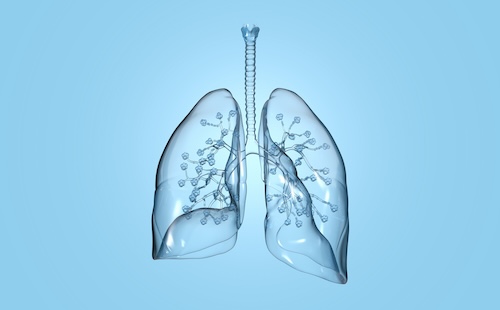Breath Explor: A user-friendly, multi-purpose breath sampling tool for drug testing and diagnostics
Breath Explor is a non-invasive and easy-to-use sampling device made in Sweden. Breath sampling is convenient for the donor; no need for syringes or intrusive supervision. With Breath Explor, sampling is so simple that a collecting officer can expect to collect ten Breath Explor samples or more per hour. To support the collection officer, we have developed a free instructive app. The samples are sent to our accredited partner laboratory for LC-MS/MS analysis.
Breath Explor collects aerosol particles from the most distal parts of the lung through impaction. The samples can be analysed for the presence of drugs-of-abuse or clinical biomarkers. The device is intended for professional use in workplace drug testing, dependence clinics, clinical studies, and the monitoring of therapeutic drugs. The Breath Explor sampling device is patented in Sweden and the USA, and patent pending internationally.
Watch a video introduction to the Breath Explor sampling device here.
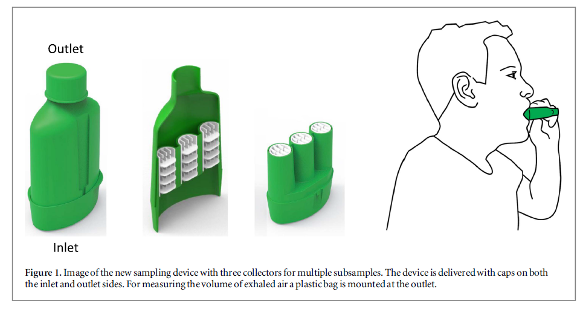
Figure 1: The Breath Explor sampling device, complete, cross-sectioned, the collector unit with three separate collectors, and in use. From Seferaj et al. 2018.
The Breath Explor sampling device consists of a collector unit with three separate collectors, a body, and two caps. The device is easily disassembled for both manual and automated robot sample preparation. Read more about Breath Explor sample preparation here. Thanks to its three collectors (see Figure 1), the device offers multiple test options from one and the same sample. This makes the device attractive for forensic, clinical, and research purposes, where confirmatory testing, or diverse testing, may be required.
Collection by impaction: How Breath Explor works
Non-volatile material collected with Breath Explor has been proven to originate in the peripheral airways, making it a highly interesting new method that should be further explored.
We are all familiar with the fact that we breathe to rid the blood of CO2 and fill it with oxygen. The alveoli are the smallest and most distal parts of the lungs, and this is where the CO2 for oxygen exchange happens (see Figure 3). Alongside CO2, the blood leaves other traces of substances and biomarkers, which get caught in the alveolar fluid. For an illustration of this exchange, see Figure 2.
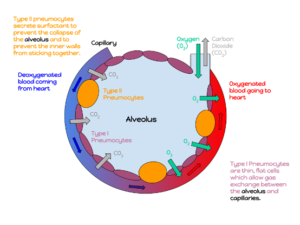
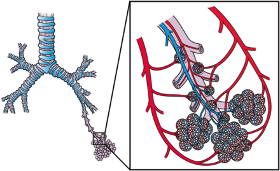 Left: Figure 2. Illustration of the capillary exchange in the alveoli, kindly provided by prof. Kjell Alving, Uppsala University. Right: Figure 3. Illustration of the alveoli inside the lung.
Left: Figure 2. Illustration of the capillary exchange in the alveoli, kindly provided by prof. Kjell Alving, Uppsala University. Right: Figure 3. Illustration of the alveoli inside the lung.
When we breathe, aerosol particles of surfactant will travel out through the mouth or nose. These are the particles which we collect with the Breath Explor sampling device. Through impaction, the aerosol particles get caught on the surfaces of the Breath Explor collectors, and can subsequently be flushed out and analysed. This method creates minimal interference from background material during the analysis phase, as shown by Seferaj et al. 2018’s comparison of Breath Explor collectors with a filter device:

Figure 4. Cleaner extracts demonstrated with mass spectrometry scanning. From Seferaj et al. 2018.
As can be seen from the curves in Figure 4, even a blank synthetic filter showed significant interference from background material (from the filter itself), whereas the blank Breath Explor (BE) collector extract shows an identical curve to pure methanol.
Read more about the science behind using breath samples for drug analysis here.
How to use Breath Explor
The Breath Explor sampling device is delivered in a protective film, with caps covering the outlet and inlet. After these are removed, the device is ready to collect a sample.
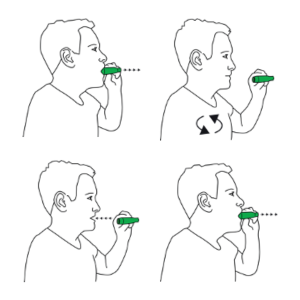
Figure 5. The breathing manoeuvre used for leaving a sample with the Breath Explor sampling device
By totally emptying, and then filling, the lungs before exhaling into Breath Explor, the most peripheral airways and alveoli will close and reopen causing increased particle formation in this region, and a 10-fold increase of DPPC in collected material.
Before breathing into the device, the person leaving the sample will breathe out, hold their breath for three seconds, and breathe in. The next exhalation is done through the device. After repeating this procedure ten to twelve times, the test is complete. This particular breathing manoeuvre is motivated by the fact that it increases particle formation in the lungs and, as a result, the amount of collected material, as described by Prof. Alving above. A complete user’s instruction (in Swedish and English) can be found here and our instructive app Breath Explor Operator Guide, which times and keeps count of the number of breaths, can be downloaded from the App Store and Google Play.
Intended purpose
Breath Explor is a tool for breath sampling for forensic toxicological use and research. The product is CE marked and registered as an in vitro diagnostic device with the classification IVDD general, in accordance with Regulation (EU) 2017/746 on in vitro diagnostic devices and the Swedish Medical Products Agency’s Regulations (LVFS 2001:7) on in vitro diagnostic medical devices. The intended use is the sampling of exhaled breath to collect aerosol particles carrying non-volatiles from the distal parts of the lung, for medical investigations and monitoring purposes. The classification IVDD General means that the sampling needs to be conducted by a professional; however, future research findings may motivate a reclassification as a device for self-sampling. The sample is intended to be analysed for occurrences of drug substances in individuals, for diagnostic purposes. The medical laboratory providing analysis must be accredited. Breath Explor is intended for professional use in workplace drug testing, dependence clinics, clinical studies, and the monitoring of therapeutic drugs. Click here to listen to Prof emer. Olof Beck’s presentation on the use of breath samples for workplace drug testing.
Potential
This section outlines potential areas of use for Breath Explor sampling, motivated by ongoing research on the Breath Explor sampling device and samples. Please note that these potential areas of use may not be covered by the product’s current Intended Use and classifications, and will require further research and different product classifications before they may be used in practice.
Forensic
Breath Explor sampling could have several forensic applications beyond workplace drug testing. Within the police, Breath Explor could be a helpful tool for the monitoring of large public events and when responding to violent crime, including domestic violence. Breath Explor could also solve a hitherto unmet need within law enforcement, which is roadside testing for THC and other substances. Read more about our work towards a mobile Breath Explor laboratory here.
For prison services, Breath Explor could simplify drug testing in prisons, as well as enable simultaneous drug testing and DNA ID of those with ankle monitors. DNA identification of convicted felons is another area in which Breath Explor sampling could be useful.
Clinical
Breath sampling with Breath Explor is currently being explored for various clinical applications. Thus far, researchers have been able to detect, for instance, viruses, bacteria, fungi and inflammatory biomarkers. A recent development during the pandemic has been to test patients diagnosed with Sars-Cov-2 (Covid-19). Studies are still in progress, but it has already been possible to detect Covid-19 in Breath Explor samples. Testing for Covid-19 with Breath Explor could have several potential advantages over nose swabs. Read more about our work during Covid-19 here.
Breath Explor could provide simple sampling within the primary care, as well as home sampling. Since the Breath Explor device is easy to use without any prior training, it would be possible for patients to test themselves without physically visiting a care provider or pharmacy, something which is becoming increasingly desired with the rise of digital care services and web pharmacies.
